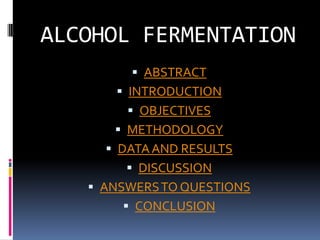
Alcohol fermentation presentation
- 1. ALCOHOL FERMENTATION ABSTRACT INTRODUCTION OBJECTIVES METHODOLOGY DATA AND RESULTS DISCUSSION ANSWERS TO QUESTIONS CONCLUSION
- 2. ABSTRACT Alcohol fermentation is done by yeast and some kinds of bacteria. These microorganisms convert sugars in ethyl alcohol and carbon dioxide. Alcoholic fermentation begins after glucose enters the cell. The glucose is broken down into pyruvic acid. This pyruvic acid is then converted to CO2, ethanol, and energy for the cell. Humans have long taken advantage of this process in making bread, beer, and wine. In these three products the same microorganism is used: the common yeast or Saccharomyces Cerevisae. Hence we used different classification of sugars in this experiment to verify its feasibility and distinction in their reaction. Moreover as this experiment aimed to degrade sugars into its glucose units, the resultant precipitate will be forming rapidly when we used the glucose as sugar. The rate of production in getting more Ba (Co3)2 will depend on the sugar component of the sample used, as long as it can be degraded into glucose the more the reaction will be possibly occur. Keywords: *anaerobic process *pyruvic acid *fermentation *sugar
- 3. INTRODUCTION ALCOHOL FERMENTATION- is done by yeast (Saccharomyces Cerevisae) and some kinds of bacteria. Baker’s yeast- commonly used as a leavening in baking bread and bakery products. -a single-celled microorganism found on and around the human body. In the process, these microorganisms convert sugars in ethyl alcohol and carbon dioxide. Alcoholic fermentation begins after glucose enters the cell. The glucose is broken down into pyruvic acid. This pyruvic acid is then converted to CO2, ethanol, and energy for the cell.
- 4. OBJECTIVES To examine the fermentation property of the different sugars. To examine the substrate specificity of fermentation.
- 6. METHODOLOGY Stir the mixture vigorously 2 hrs in warm location Then, after the recovery of Ba(Co3)2 , weigh the precipitate, note the result.
- 7. DATA AND RESULTS ALCOHOL FERMENTATION CARBOHYDRATE AMOUNT OF PRECIPITATE (g) Glycerol No precipitate Glucose 0.60 Sucrose 0.40 Starch 0.20 Fructose 0.20 Maltose 0.20
- 8. DISCUSSION Anaerobic respiration- obtain of energy without the presence of oxygen. Two examples of anaerobic process: 1. Glycolysis- chemical breakdown of glucose to lactic acid. 2. Alcoholic Fermentation- glucose is broken down into pyruvic acid. This pyruvic acid is then converted to CO2, ethanol, and energy for the cell. ~Therefore, both alcoholic fermentation and glycolysis are anaerobic processes that begin with the sugar glucose.
- 9. Comparison of Glycolysis and Alcoholic Fermentation
- 10. DISCUSSION Fermentation process- starts with one molecule of the six carbon sugar-glucose, and terminates with two molecules of the two carbon alcohol- ethanol, and two molecules of carbon dioxide. Yeast- belongs to the Saccharomyces Cerevisae species. - it converts sugars in ethyl alcohol and carbon dioxide. 3% Barium hydroxide and mineral oil- the solution that will react with the yeast and sugar solution. Mineral oil- acts as a protection from atmospheric carbon dioxide that is present in the air. Barium carbonate- the final by-product obtain in the alcohol fermentation.
- 11. DISCUSSION REASONS WHY GLYCOGEN DID NOT PRODUCE BARIUM CARBONATE: 1. The major role of glycerol is to maintain the redox balance. 2. Ethanol production in the process ensures reoxidation of the NADH formed during the oxidation of glyceraldehyde 3-phosphate, is a redox-equilibrated process, excess NADH is produced during biomass formation. 3. Glycerol is mainly produced to counterbalance this surplus of NADH and may be considered to form a redox valve. 4. Glycerol production may play an important role in balancing the ratio of free to bound phosphate in the cytosol. 5. Essential role of glycerol as a compatible solute during hyperosmotic stress.
- 12. ANSWERS TO QUESTIONS 1. Explain why glycerol is not fermented under the given set condition. -From the principle of alcohol fermentation, it convert sugar to ethyl alcohol and carbon dioxide. In the case of glycerol, which is not a sugar it cannot be degraded that is why there is no reaction that occurs in the process. But glycerol is the by- product produced on alcohol fermentation. 2. How does yeast get fructose into glycolysis? -The main role of yeast in the process is to convert sugar to ethyl alcohol and carbon dioxide. Fructose is a sugar, so yeast reacts with the hemiacetal side of the fructose and bring fructose in the process of glycolysis.
- 13. 3. What class of glycosidase enzyme must yeast possess to effect fermentation of carbohydrates? -In order to effect fermentation, the yeast must possess the enzyme ALCOHOL DEHYDROGENASE. It catalyzes ethanolic fermentation reaction to form ethanol using glucose (a carbohydrate) as substrate.
- 14. 4. What monosaccharaides would be produced by hydrolysis lactose, maltose, sucrose, and starch and which of these reactions yeast seem able to carry out? Explain. -The main monosaccharide that would be produced is glucose. Of all these reactions, yeast will react more with maltose because it contains two glucose units. Glucose is the main sugar that can react fast to yeast during alcohol fermentation. 5. Write a balance equation for the reaction of gas with barium hydroxide. -Barium has a charge of -2 and Oxygen has a charge of +2. Oxygen is nature appears as O2, therefore Barium + Oxygen = barium oxide; Ba + O2 = BaO; 2Ba + O2 = 2BaO
- 15. CONCLUSION ATP(adenosine triphosphate) – main source of energy in cells. Carbohydrates- main source of energy for organisms. Different kind of sugars: 1. Monosaccharides- glucose, fructose, mannose and galactose. 2. Disaccharides- maltose, sucrose, lactose and cellobiose 3. Polysaccharides- starch, cellulose and glycogen
- 16. CONCLUSION MONOSACCHARIDES SPECIFICALLY GLUCOSE = FAST ALCOHOL FERMENTATION REACTION+ MORE BY-PRODUCTS DISACCHARIDES & POLYSACCHARIDES = SLOW ALCOHOL FERMENTATION REACTION+ LESS BY-PRODUCTS
